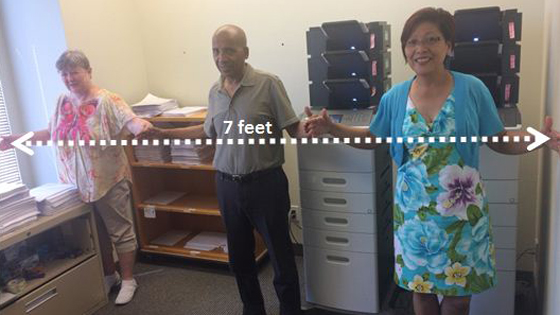
Doreen Knott, Adem Hussen, and Maria Sojor from Transcription Services demonstrate the seven feet of paper saved each month. (Photo: UHN)
When Transcription Services clerical staff members Maria Sojor, Doreen Knott, and Adem Hussen began each day at work last fall, they were faced with huge stacks of paper. Rolled up over the course of each month, a wall of paper literally stood between them and a more efficient use of their time.
Clerical staff at UHN's Health Records and Transcription Services department – like Maria, Doreen and Adem - along with their colleagues and volunteers, manually sort, process, and mail out Discharge Summaries and other patient reports to primary care providers and referring physicians on a daily basis.
This is a necessary step for reports that have inaccurate or missing recipient contact information documented in patients' records. But, as they discovered, it also has the potential to produce a large paper trail.
A huge impact though incremental quality improvements
Committed to improving the completion, quality, and delivery of Discharge Summaries, UHN launched the Quality Improvement Plan (QIP) Discharge Summary project in fall 2014.
One of the deliverables of the project was an accurate and complete Provider List to ensure that patient reports were sent out on time and to the right recipients.
Since then, the Patient Care Management Systems (PCMS), Data Security, and Project Team at SIMS have been collaborating with Health Records and Transcription Services to trial and roll out a series of auto-fax logic changes in UHN's Electronic Patient Record (EPR) system.
The results so far
Thanks to this work, Transcription Services has seen a whopping reduction of seven feet of paper or 16,000 reports per month to manually sort and mail out. Spread out over the next year, that's a minimum of 84 feet of paper saved.
Did you know?
- Each month at UHN, an average of 3,000 in-patients are discharged, and 3,800 Discharge Summary reports need to be sent to primary care providers/referring physicians
- UHN can auto-fax an electronic Discharge Summary to a recipient in just 30 minutes of it being completed, if the recipient’s contact information is accurate
- When recipient contact information is missing or inaccurate, it takes an average of 6-12 days to manually process reports prior to mailing via Canada Post
Not just about saving trees
Besides the substantial cost savings for paper, there have also been additional savings for envelopes and stamps needed to mail out the printed reports.
Time previously spent sorting, shuffling, and manually processing thousands of reports, is now more efficiently used by volunteers and staff at Transcription Services to validate and update provider contact information, and continually work towards the overall goal of real-time accuracy and completeness for UHN's Provider List.
"We no longer have to sort through large amounts of paper reports, only to end up discarding them as the provider recipient was listed as 'None' or 'Unknown,'" says Doreen.
"Optimizing the use of the team's time has been extremely beneficial," she says. "It has allowed us to use our work to proactively ensure an accurate and up-to-date Provider List at UHN rather than trying to play catch-up with unsuccessful faxed reports."
Moving forward
Buoyed by this success, Transcription Services is looking forward to future quality improvements implemented in collaboration with the PCMS and Data Security Teams, and the UHN QIP Discharge Summary project.
Turning what seemed to be an insurmountable challenge into a manageable opportunity is a huge success, says Maria.
"This is no longer a huge mountain," she says. "Now it's just a small hill to climb!"
